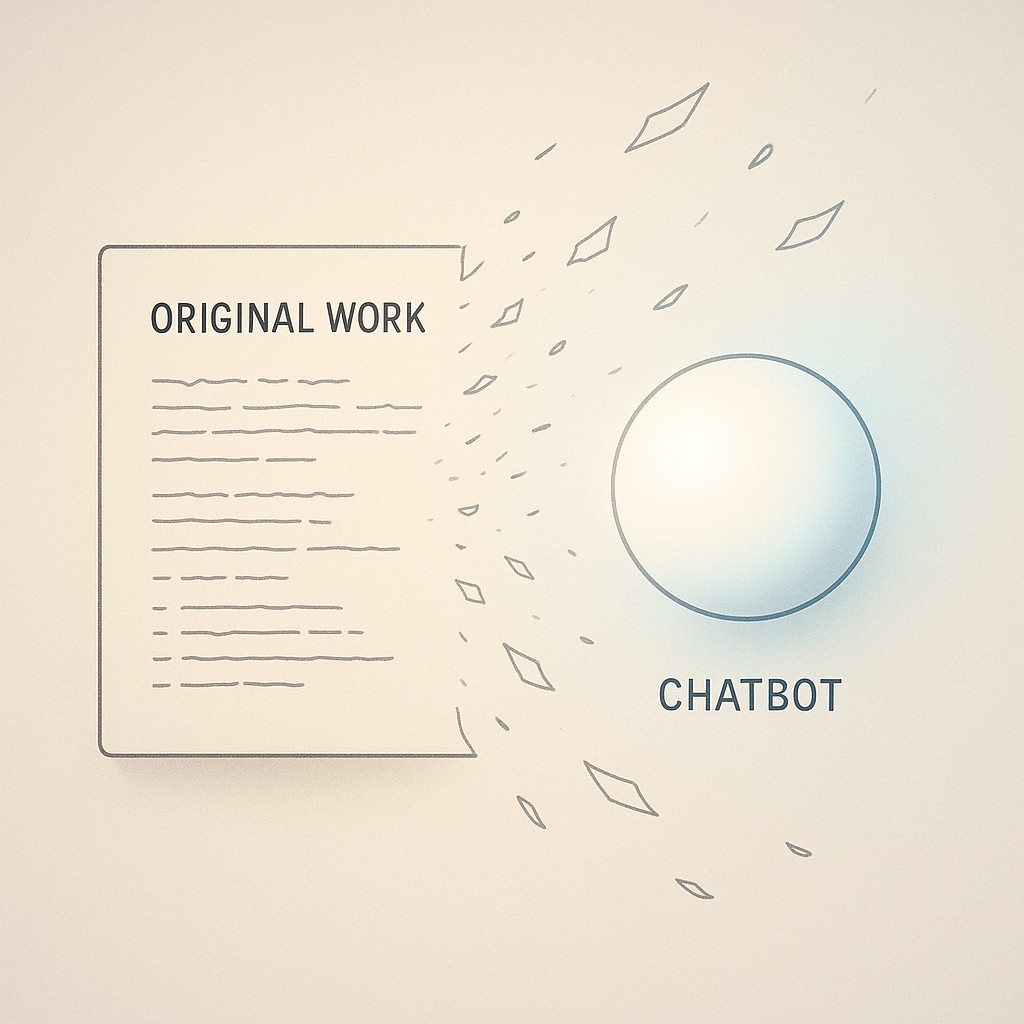Get Cited by AI Models: Build Canonical, Branded Assets
Get Cited by AI Models: Build Canonical, Branded Assets

Discovery Is Changing—And Attribution Is Disappearing
ChatGPT, Perplexity, Google’s AI Overviews—these bots aren’t just making search easier. They’re skipping the link entirely. Since the U.S. launch of Google’s AI Overviews in May 2024, the number of searches for news that result in no click-throughs to news websites has grown from 56% to nearly 69% by May 2025, according to Similarweb data. I actually think that’s true. It’s just how the interface works, and unless something shifts, the curve only looks steeper. I used to think there would always be a trail leading back to the source, but lately there’s just… absorption.
You spend weeks crafting an original guide. A user asks a chatbot a question. The answer comes back, everything you said, but there’s no link, no mention of your name, not even a hint that the work was yours. No lead. No click. Just… absorption. That’s it.

So now, we’re not just writing for humans anymore. We’re writing for models. It’s a strange feeling—like the room got bigger, but no one is looking directly at you.
What does content marketing look like when your goal is to get cited by AI models as discovery happens through an LLM response instead? That’s the shift: making content that’s so memorable, so canonical, it survives the summary and gets cited by name—because that’s where authority and recognition will live next.
Why Discovery Is Getting Flattened—and How Identity Wins
Right now, we’re living through a shift where “just Google it” almost always means “ask a bot, get an answer.” The promise is efficiency. You ask, you get a summary. There’s no pause, no clickable list—just a single blurted response. Whatever comes back sounds confident, and the source? Optional. The interface itself has turned search into a summarization step, sandwiched quietly between you and the work someone else spent hours crafting.
Here’s what most people miss. Large language models don’t actually “know” things. What they do is blend everything they’ve read and spit out the average. If your piece sounds like everyone else’s, it just gets mashed into this composite soup—reduced to a line or two that could’ve come from anywhere. All that effort to be helpful? If it isn’t distinctive, your work vanishes into the baseline. Your content becomes the average.
The marketers who break out of this fate build canonical authority that models can grab onto. That means work with a strong, recognizable identity—think unique claims, unmistakable phrasing, even frameworks or coined names nobody else can claim. But it’s more than just style. When you attach signals that models recognize (author bylines, structured data, consistently linked assets, maybe even schema and citations baked in), the models have somewhere to anchor. This is how content gets referenced by name, even in a compressed, AI-mediated world. Canonical doesn’t just mean “the best version.” It means “the source everything else refers back to.” You made your work unmissable and unmistakable at a technical level and a human one.
Still, I’ll admit: I don’t think anyone—not me, not the “experts”—has totally figured out how this plays out. The ground is moving under all of us. There’s a lot we don’t know about how these models decide who gets credit. Sometimes I wonder if all our attempts to outsmart the system are actually making our content blend in even more, but I keep circling back to identity anyway.
But if discovery is getting commoditized, the edge moves upstream. The real win now is being the thing models and people both remember, request, and actually cite by name—even when no one’s really searching anymore.
Ship Distinctive, Named Assets to Get Cited by AI Models—Give Models a Reason to Remember You
Here’s the AI attribution strategy for being remembered. Name your ideas, build canonical assets, and create a single source of truth that both models and people can latch onto. When something stands out, people are more likely to recognize it and remember where it came from—the classic von Restorff effect shows this for both recognition and source memory. It’s not enough to just add value; you’ve got to build value that gets associated with your brand, even when it’s summarized.
Let’s talk about the playbook. First, give your best ideas unique names. Not “SEO tips for small teams”—make it “The Solo SEO Ladder” and use that language everywhere. Next, dedicate canonical pages to these named ideas, not just blog posts buried in categories. Add JSON-LD schema to your pages to broadcast clear brand signals for LLMs—so machines know exactly who made your content, which brand it belongs to, and what’s linked, moving from assumptions to certainty. You want author identity visible. Real bylines, photo, short bio.
Summarize your frameworks or processes in bullet lists or diagrams, right on the page, so if a chatbot grabs a snippet, it mirrors your phrasing. Use the same memorable language everywhere—headlines, openers, meta descriptions—so the terms survive compressive summarization and build “stickiness” in both models and minds. It’s technical, but it’s really about being obvious, legible, and consistent.
Messy moment here, sneaking in: Earlier this year I realized I had been calling my main framework three different things depending on whether I was writing a blog post, talking on a podcast, or submitting a conference deck. One tiny difference in phrasing and suddenly it didn’t matter how much effort I put in—the model picked the version it had seen most often (which ended up being the least descriptive one)! I still keep catching myself reverting to old language. Sometimes your biggest friction is just a stubborn muscle memory.
Here’s how I picture it. Regular, undistinctive content is like a nutrition shake—the model slurps it down, extracts the protein, and you never taste anything. Branded, canonical work is a full meal. It’s distinct, layered, hard to blend away, and worth returning to. Or maybe you just wind up serving anonymous nutrition, your flavor diluted until nobody knows it was yours.
So, layer on the assets nobody else has if you want to get cited by AI models. That means original benchmarks, raw datasets, usable code snippets, unique diagrams—stuff that gets cited repeatedly in ChatGPT, Perplexity, Google, podcasts, paid ads, and social posts. The goal is to create artifacts that don’t flatten into bullet points. People bookmark these for reference; models cite them because they’re the only comprehensive source.
Ship assets that are easy to cite and hard to flatten. Make your work the go-to reference for both humans and machines.
How Small Teams Can Actually Make This Work
Let’s clear the air. You don’t need a staff of ten or a budget that scares your accountant. Most of us are fighting this battle with limited hours and a tiny toolkit. The good news is, you don’t have to flip your workflow upside down to start winning attribution. If you focus on the 80/20—that is, the high-leverage moves that take less time but make a bigger dent—you’ll see traction fast. If your cadence looks like “ship something new every two weeks,” this can fit. No guilt if last month just didn’t line up. This is about moving forward, not catching up perfectly.
Here’s your go-to checklist—stuff I actually use, not theoretical fluff. First up, name your main framework or process, and stick to it everywhere, from your blog to your slide decks. Publish a single, canonical explainer that lays out your approach clearly; don’t scatter it across ten posts.
Add JSON-LD structured data (if you’re not sure how, most CMS platforms have simple plugins for this) so Google and chatbots know you exist. Build a glossary that anchors your language—unique terms, coined phrases, shorthand that nobody else uses. Ship a benchmark or a tiny dataset if your field supports it; original numbers, even if rough, make models reference you. And don’t let these assets just sit—seed them in all the visible places: developer channels, podcasts, paid ads, social threads. The goal isn’t to go viral in a week—it’s to plant persistent signals across every spot where models and humans might look next.
If you’re wondering how this fits with SEO, here’s the shift. You’re not abandoning SEO at all. You’re making SEO the natural byproduct of demand for your named ideas. As people and models reference your work, the signals build themselves, and ranking follows. It’s slower, but it’s compounding.
How do you know it’s working? The fastest test is to run your brand or idea through a chatbot prompt, or check the Perplexity source panel—see if your canonical asset shows up. Nudge the model by using consistent naming. If the LLM spits back your language or directly quotes your framework, something’s sticking. Iterate based on what gets mentioned and keep refining until you see your work reflected, not just summarized.
Use the app to generate structured, brand-anchored, LLM-friendly content with bylines, schema, and consistent language, so models and readers remember and cite you.
Back to that shake metaphor from earlier—if users don’t land on your page anymore, pay attention to where your ideas and language still travel. That’s real progress. Your influence isn’t limited to pageviews; it’s embedded in the answers models give.
How to Measure, Adapt, and Maintain Attribution—Even as Models Evolve
The real test isn’t just pageviews anymore—it’s whether your work gets cited, recognized, and requested by name, even when the interface cuts you out. So shift your tracking to things that actually reveal attribution and memorability. Watch for citations in Perplexity’s reference panels. Run brand-search reports to spot upticks when people look you up directly. Skim through developer channels, forums, and GitHub for requests or mentions that reference your named frameworks or coined concepts. Your goal is to see your work show up where summaries are built and conversations happen, not just where traffic lands.
Set up a simple monthly cadence for audits. Once a month, check if your brand or framework is showing up in ChatGPT and Perplexity answers—rerun core prompts and look for direct mentions or links. Do regression tests by running your canonical pages through the models and just spot drift or dilution as the algorithms update. This routine keeps you one step ahead so your identity stays sticky, and you catch loss-of-attribution early.
It’s never set-and-forget. These models update faster than we’d like to admit. Keep your schema up-to-date and refresh your canonical summaries so machine-readable content signals are current and unambiguous for models to latch onto. The builds compound when you earn third-party citations that large language models actually respect—those carry over across model updates and raise your baseline authority.
So here’s your charge: invest in identity and canonical authority right now. If you don’t, your content becomes the average—the stuff nobody remembers, nobody asks for by name, and nobody credits even when you were the source. Build foundations that models and people cite, and you’ll get recognized even as discovery collapses into a single answer.
Enjoyed this post? For more insights on engineering leadership, mindful productivity, and navigating the modern workday, follow me on LinkedIn to stay inspired and join the conversation.
